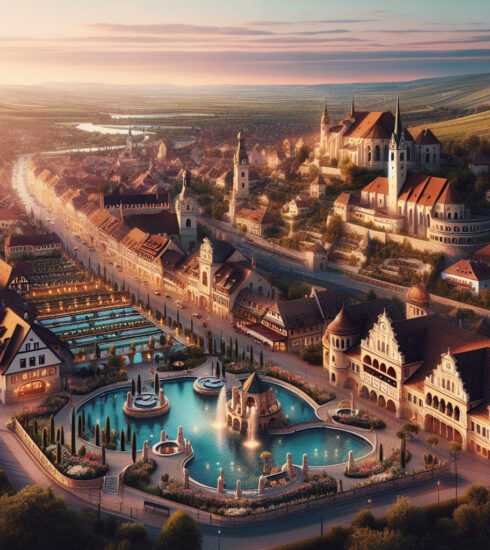Discover Hungarys Captivating City Legends: Exploring Enchanting Tales That Stand the Test of Time
Introduction
Hungary, with its rich history and vibrant culture, is a country filled with timeless legends. From Budapest, its magnificent capital city, to the enchanting towns and villages that dot the countryside, Hungary offers a plethora of captivating stories and tales. In this article, we will delve into the depths of Hungary’s city life and uncover the fascinating legends that have shaped its urban landscapes. Join us on a journey through time as we explore the hidden gems, the historic landmarks, and the intriguing folklore that make Hungary’s city life truly enchanting.
Budapest: The Jewel of Hungary
The city of Budapest, often referred to as the “Pearl of the Danube,” is a remarkable blend of old-world charm and modern sophistication. As the capital and largest city of Hungary, Budapest is home to some of the country’s most iconic landmarks and cultural treasures. Let’s begin our exploration of Hungary’s timeless legends in this vibrant metropolis.
The Legend of Buda Castle
Perched on the Castle Hill overlooking the Danube River, Buda Castle is one of Budapest’s most recognizable landmarks. This majestic fortress has a long and storied history, with legends dating back to the medieval era. According to one popular legend, the castle is haunted by the ghost of King Matthias Corvinus, a renowned ruler of Hungary in the 15th century. It is said that his spirit still roams the halls of the castle, keeping a watchful eye on his former domain.
In addition to its supernatural tales, Buda Castle also has a more practical legend associated with it – the tale of the “hidden treasure.” According to local folklore, a secret underground passage leads to a hidden chamber within the castle, where a priceless treasure is said to be hidden. Many adventurers and treasure hunters have tried to uncover the secret of the hidden treasure, but to this day, it remains undiscovered.
The Mystery of the Parliament Building
Another iconic landmark in Budapest is the Hungarian Parliament Building, an architectural masterpiece that dominates the city skyline. This grandiose structure has its fair share of legends and mysteries surrounding it. One such legend involves the Holy Crown of Hungary, which is housed within the parliament building. According to the tale, anyone who attempts to steal or harm the crown will be cursed with misfortune for the rest of their lives.
Another intriguing legend relates to the construction of the parliament building itself. It is said that the architect, Imre Steindl, made a pact with the devil to complete the building within a short span of time. In exchange, the devil would claim Steindl’s soul upon completion of the project. However, the resourceful architect managed to outsmart the devil by designing the building in such a way that the devil could not enter. Thus, he was able to keep his soul and complete his masterpiece.
Exploring the Ruin Bars
Budapest is also famous for its unique ruin bars, which have become an integral part of the city’s nightlife scene. These bars are located in dilapidated buildings and courtyards, giving them a distinctive charm and a sense of history. One of the most renowned ruin bars in Budapest is Szimpla Kert, which is known for its eclectic décor and vibrant atmosphere.
The legend of the ruin bars is closely tied to the concept of “ruin tourism.” In the early 2000s, a group of young entrepreneurs started transforming abandoned buildings into trendy bars and cultural spaces. The success of these establishments sparked a wave of revitalization in Budapest’s neglected districts, attracting tourists and locals alike. Today, the ruin bars are a testament to Budapest’s resilience and creativity, as well as a symbol of its ever-evolving city life.
Uncovering the Hidden Gems of Hungary’s Cities

While Budapest may steal the limelight, Hungary is home to numerous other cities that hold their own timeless legends and enchanting tales. Let’s venture beyond the capital and explore the hidden gems of Hungary’s city life.
Debrecen: The Calvinist Rome
Located in the eastern part of Hungary, Debrecen is known as the “Calvinist Rome” due to its strong Protestant heritage. This vibrant city played a significant role in Hungary’s history, particularly during the revolution of 1848. One of the city’s most enduring legends is tied to Kossuth Square, a central plaza named after Lajos Kossuth, a key figure in the revolution. It is said that the square is haunted by the spirits of those who fought for Hungary’s independence, their voices echoing through the corridors of time.
In addition to its revolutionary history, Debrecen also boasts a unique legend involving its famous Great Reformed Church. According to local folklore, the church was once inhabited by an eccentric hermit who lived in its bell tower. Legend has it that he possessed magical powers and could predict the future. To this day, visitors to the church can still feel a lingering sense of mystery and enchantment.
Pécs: A Tapestry of Cultures
Pécs, located in the southern part of Hungary, is a city known for its rich cultural heritage and architectural splendors. One of the city’s most fascinating legends relates to its early Christian burial chambers, which date back to the Roman era. According to local folklore, these ancient tombs are linked by a series of secret underground tunnels. It is believed that these tunnels were used by early Christians to escape persecution and worship in secret.
Another notable legend in Pécs revolves around the Mosque of Pasha Qasim, a stunning example of Ottoman architecture. Legend has it that the mosque’s minaret was built by the devil himself, who was enlisted by the pasha to construct the tower in a single night. However, the devil’s mischief got the best of him, and he accidentally placed the minaret upside down. Visitors to the mosque can still see the upside-down minaret, which stands as a testament to the power of legends and the enduring spirit of Pécs.
Érd: The Legend of the Dankó Pista Fountain
Érd is a town located just outside of Budapest, known for its lush greenery and charming atmosphere. One of Érd’s most beloved legends revolves around the Dankó Pista Fountain, a whimsical sculpture located in the town center. The legend tells the story of Dankó Pista, a young shepherd who fell in love with a beautiful fairy. The fairy granted him three wishes, and Pista used them to bring prosperity and happiness to the town of Érd.
Today, the Dankó Pista Fountain is a symbol of hope and community spirit. Locals and visitors alike gather around the fountain to make a wish or simply enjoy the enchanting atmosphere. Whether the legend is true or not, the impact of Dankó Pista’s story can be felt throughout the town, reminding everyone of the power of dreams and the importance of cherishing the legends that shape our lives.
Conclusion
Hungary’s city life is a tapestry of timeless legends, enchanting tales, and captivating stories. From Budapest’s haunted castles to the hidden gems of Debrecen, Pécs, and Érd, Hungary offers a wealth of folklore and myth that adds depth and character to its urban landscapes. As you explore Hungary’s cities, be sure to immerse yourself in the rich history and folklore that permeate these vibrant communities. Uncover the hidden legends, hear the echoes of the past, and let yourself be enchanted by the timeless tales that continue to shape Hungary’s city life.
Internal links:External link:For more information on Hungarian history and culture, visit Wikipedia’s page on Hungary.






